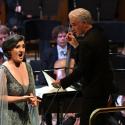Kahchun Wong’s final concert of 2024 in the Hallé Manchester season was something of a surprise. At first sight, the sparkle in the programme seemed likely to come from James MacMillan’s Veni, Veni, Emmanuel – his percussion concerto, with the star name of Colin Currie as soloist – and from Malcolm Arnold’s Four Scottish Dances (especially the third of them) to precede it.
Afterwards, it was to be Beethoven’s Seventh Symphony to finish, and that’s been played and heard many times before. In the event, the first two works did sparkle, but the symphony intrigued.
The Arnold dances are great fun: for the French horns in particular, and for the first bassoon (Georgie Powell on this occasion), who gets a chance to play like a sozzled Scotsman reeling his way home. But the jewel is the magical song-without-words Allegretto, with its glorious flute and oboe solos to harp accompaniment and its richness of colour. Kahchun Wong took it gently and tenderly, as it should always be, and brought it to a beautiful close.
The percussion concerto was a good choice for Advent Sunday, since it makes use of the eager-forward-looking associations of the traditional hymn (originally plainchant), “O come, O come, Emmanuel”. In MacMillan’s hands it becomes an answer to thematic questions posed earlier in the piece, which explores a myriad of virtuoso percussion techniques and works up its tension through changing “pulse rates”, with an almost breathless sense of expectancy in a passage for marimba over super-soft orchestral background… after which the distant chant of “Rejoice, rejoice,” becomes gradually more audible. The balanced sound of muted trumpets and trombones united with soft woodwind was magical here in Wong’s hands, and Colin Currie’s performance was both energetic and exciting. The end of this piece is a surprise in itself if it hasn’t been heard before, as the orchestra members play a multiplicity of chime bars and the soloist migrates to the tubular bells for a final clangorous sheen of sound (quoting an Easter chant). But the Beethoven symphony was the bigger surprise. Kahchun Wong had a large body of strings in his orchestra (by today’s standards) with 50 of them on stage, and he had everyone standing (except for the cellos and basses) where at all possible (pictured above). It’s not a new phenomenon: Sir Mark Elder tried it with Brahms quite early on in his tenure with the Hallé – but the interesting thing was Wong’s approach to this symphony in the light of those arguably anachronistic string numbers. There were traditional kettle drums, but present-day horns and trumpets.
But the Beethoven symphony was the bigger surprise. Kahchun Wong had a large body of strings in his orchestra (by today’s standards) with 50 of them on stage, and he had everyone standing (except for the cellos and basses) where at all possible (pictured above). It’s not a new phenomenon: Sir Mark Elder tried it with Brahms quite early on in his tenure with the Hallé – but the interesting thing was Wong’s approach to this symphony in the light of those arguably anachronistic string numbers. There were traditional kettle drums, but present-day horns and trumpets.
Beethoven comes trailing clouds of tradition, of various kinds. In some parts of the world he’s still expected to be portentous and even a bit solemn – in others, conductors dash through his symphonies at the fastest speeds they think they can get away with. This one was a subtle combination of effects: the standing string players seemed to have more freedom in their bowing arms than commonly met in normal conditions, while their seated colleagues did not. It was by no means bass-heavy, if anything the opposite.
But it was weighty. The opening slow tempo was deliberate indeed, and followed by a Vivace that wasn’t very fast either, but the contrast was there, and the extra breathing room allowed principal flute Amy Yule to characterise her line in the main subject quite soloistically, and Hallé leader Emily Davis to urge her troops to lively articulation, too. There were vivid dynamic contrasts, even in mid-phrase, and Wong treated the music as drama just as much as any Beethoven.
The second movement was a model of clarity and contrapuntal balance, building its power neatly into the wind entry and hitting an unmistakable peak before the end.
Then the dancing (for some the whole theme of the symphony) began. The scherzo is marked Presto, but this one had room to slow down a little more than usual in its trios – the second almost monumentally so – and the gentle return to the main theme different again from its first outing.
Wong segued into the finale without a pause, and that was good fun, too, in a rather Germanic way: logic prevailed, textures were open and there was a definite highspot. For Beethoven from a big body, it made plenty of sense.















Add comment